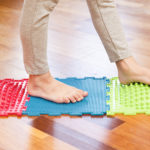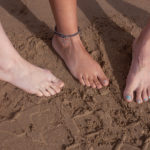Innovative flatfoot surgery releases Quinn’s inner athlete

By the time he was 10, Quinn’s parents had tried almost everything. Dawn would sometimes massage his feet to relieve the pain and tightness caused by flexible flatfoot, a condition in which a child has very little or no arch in their feet. Joseph did physical therapy exercises with him at night. But despite their diligence, and the special inserts he wore in his shoes, Quinn’s feet did not get better. Instead, the condition limited his activity and continued to cause pain, especially as he got older.
An uncommon case of a common childhood condition
Almost all toddlers have flat feet, but most children’s feet develop arches over time. Not Quinn. The severity of his foot condition started to show when he was 3, during a family vacation. “All of a sudden, Quinn started crying out in pain,” says Dawn. “His father had to carry him back to the hotel. He could only crawl or be carried for the rest of that weekend.”
As soon as they got home, Quinn’s parents made an appointment with his pediatrician and eventually found Dr. Susan Mahan of the Lower Extremity Program at Boston Children’s Hospital. She recommended conservative treatments to help make Quinn’s feet more functional and give his feet time to develop arches. For the next seven years, these approaches worked, to an extent. His feet were less painful, and he could walk, play, and do most kid-type things.
He couldn’t run as fast as other kids, but Quinn learned to compensate. He played baseball and almost always made it to base thanks to his strong batting skills. “Thank goodness he could drive the ball into the outfield,” says Dawn.
He never even thought of playing basketball, knowing the constant running would cause too much pain. Football seemed OK at first. He played guard on the offensive line, a position that involved more blocking than running, but soon his feet became painful after every practice. Quinn was 10 at the time.
“We went to see Dr. Mahan,” says Dawn. “She said, ‘OK, we’ve tried options one (physical therapy) and two (shoe inserts). Let’s talk about option three.’” Option three was surgery.

A new surgical option for flatfoot
Time, it turned out, was on Quinn’s side. Historically, foot reconstruction has been the only option for the small number of patients who need surgery for flexible flatfoot. Dr. Mahan, however, had recently traveled to Italy and received training in a less invasive surgical procedure with a far shorter (and less painful) recovery period.
New to the United States but practiced in Italy for decades, subtalar extra-articular screw arthroereisis (SESA) involves making a small incision near the ankle and inserting a screw next to the joint. The screw stabilizes the foot and holds the foot in an arched position.
The screws can be safely removed after three years, when the foot has grown into its new position. In the meantime, after a few months of recovery, kids like Quinn can run and play without pain or limitation.
The end of pain from flexible flatfoot
When Dr. Mahan told them about the SESA procedure, Quinn’s family didn’t hesitate. “We were all on board,” says Dawn. “We didn’t want to go down the road of foot reconstruction.”
Quinn was 11 in September 2020 when he had surgery on his left foot. In January 2021, he had surgery to correct his right. In addition to inserting screws to realign his feet, Dr. Mahan also lengthened his extremely tight Achilles tendons — a common issue for kids with flexible flatfoot. After each procedure, he missed a day of school, wore a cast for six weeks, and a boot for another two weeks.

By April, Quinn was playing baseball again and played football in the fall. Over the winter, he played for the town basketball team. Dr. Mahan will remove the screws from his feet in two years, but he has already taken off, no longer held back by painful feet.
“We call Dr. Mahan our angel,” says Dawn. “Quinn’s feet are beautiful, and he can play the sports he always wanted to play. Most importantly, he is pain-free.”
Learn more about the Lower Extremity Program or book an appointment.
Related Posts :
-

A minimally invasive surgical option for children with flexible flatfoot
Most children with flexible flatfoot, a common condition in which arches do not develop in the feet, don’t need ...
-

A new option for teens with painful bunions
Bunions, bumps at the base of the big toes, are probably not at the top of most kids’ list of ...
-

Clubfoot bracing for an active boy: Finn’s story
When Finn Beaulieu learned how to say elephant, he ran around the house repeating the word at least 20 times. When ...
-

One family, two very different clubfoot experiences
Theresah Boateng and her daughter Eno Agyapomaa Agyemang both have strong wills and outgoing personalities. Both were born with a ...





